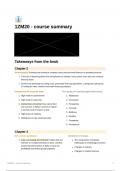Samenvatting
Extended Summary: Technology Entrepreneurship (1ZM31)
This is an extended summary of all lectures for the course Technology Entrepreneurship (1ZM31). This 52-page document summarizes the essence of all topics covered in the course (as far as I could imagine when writing it). It includes as many images & visualizations as possible to clarify the concep...
[Meer zien]




